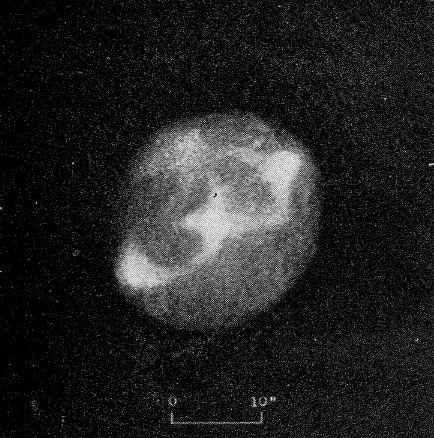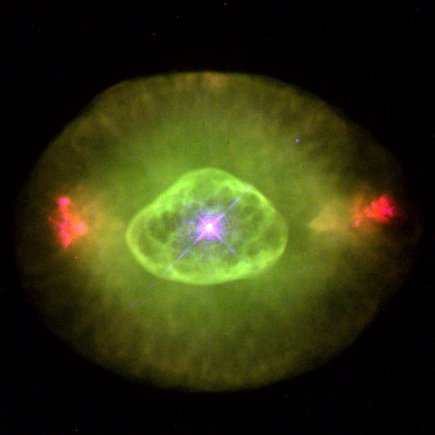NGC 6826
Among the brightest of planetary
nebulae, NGC 6826 (for some odd reason, perhaps appearance,
called by some the "Blinking Nebula"), lies in far northwestern Cygnus 11 degrees west-northwest of Deneb. From his drawing, Curtis (left) saw
considerable detail in this relatively large (25 seconds of arc
across) object, including the ejected jug-handle-like ansae seen
emerging from the left and right sides of the Hubble image on the
right (the classic case that of the Saturn Nebula, NGC 7009). Their red color comes from
radiation from ionized nitrogen,
whereas the greenish cast of the rest of the nebula is from twice-
ionized oxygen.
Curtis has a lot to say: "The central star...is surrounded by an
oval disk of bright matter. Within this are rather obscure
evidence of a brighter ring formation, the condensations at the
ends of which are 22" apart." The Hubble image, rather reminiscent
of NGC 7009, reveals a compressed complex inner structure
surrounded by an outer shell. At a best-estimated distance of 3600
light years, the nebula is between 0.4 and 0.5 light years across,
the result of a relatively low expansion velocity of 11 kilometers
per second. NGC 6826, however, is one of the few nebulae
surrounded by a relatively bright outer giant halo some five times
the size of that seen here, 65", more than two light years wide,
the result of earlier episodes of stellar mass loss illuminated by
ultraviolet radiation from the star leaking into it. The classic
case of of nebulae with such haloes is the "Cat's Eye Nebula," NGC 6543.
Shining with a bright visual magnitude of 10.7, the star's
temperature hovers around a coolish (for such objects) 47,000
Kelvin. A luminosity of 1300 times that of the Sun giving a low mass around 0.55 times solar.
Still heating at a constant luminosity, when the star hits around
100,000 Kelvin, it will begin to cool and fade, the ultimate result
(once the nebula dissipates) a common lower-mass white dwarf. Consistently,
there is little evidence for enriched elements from the star's
interior (though the carbon abundance may be somewhat high).
Left: Image by H. D. Curtis from Publications of the Lick
Observatory, Volume 13, Part III, 1918. Right: B. Balick, J.
Alexander (U. Wash.), A. Hajian (USNO), Y. Terzian (Cornell), M.
Perinotto (U. Florence), P. Patriachi (Arcetri), and NASA.



